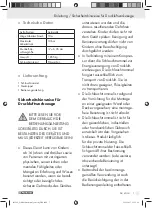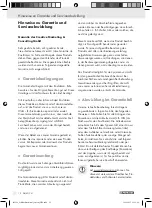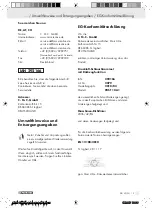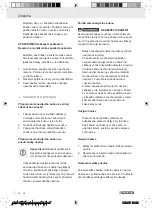
GB/IE/NI
20
1. Use the swivelling attachment bracket as a tem-
plate. For this, mark the position of the bores
on the carrier material with a pen.
2. Drill the holes required for installation into the
carrier material.
3. Attach the hose drum with suitable attachment
material.
z
z
Starting up
Connecting the hose drum to a
compressed air source
1. Wind a sealing band (not enclosed) around
the thread on the rear of the hose drum.
(see fig. B).
2. Screw the barbed fitting onto the thread.
3. Plug a connection hose for the compressed air
source onto the barbed fitting.
Connecting the hose drum to a
pneumatic tool
Note:
Danger of damage!
Improper handling of the air-driven hose
drum may cause damage.
z
Always observe the maximum working
pressure of the air-driven hose drum and that
the connection pieces used match. The quick
coupling of the working hose permits imme-
diate connection between it and a pneumatic
tool via its air inlet.
Using the hose drum
DANGER OF INJURY!
The hose drum is equipped with a return mech-
anism. It is operated by a strong spring. If the
compressed air hose is rolled up improperly there
may be injuries.
z
Never let the compressed air hose whip back
uncontrolled.
z
If the return mechanism is damaged, take the
air-driven hose drum out of operation at once.
Have the resulting damage repaired by a
specialist.
z
The hose drum has a latching and return
mechanism. This permits easy extension and
return of the working hose.
z
This latching mechanism produces a grind-
ing sound at winding and unwinding. This is
not a fault. If the sound changes after multiple
uses and/or if there are any problems with the
mechanism, get professional help or contact
the customer service.
Unwinding the hose
z
Carefully extend the working hose from the
drum housing to the desired working length for
the pneumatic tool. The latch will engage if you
release the compressed air hose after you have
heard a click.
Winding up the hose
1. Briefly pulling the working hose will release
the latch.
2. Ensure that the working hose is re-wound into
the drum housing in a controlled manner.
Setting the hose stopped
The position of the hose stopper can be set; it inter-
rupts winding up of the working hose at the desired
length. You need a Phillips-head screwdriver to
adjust the hose stopper.
1. Release the attachment screws with the Phillips-
head screwdriver (see fig. E).
2. Push the hose stopper into the desired position
along the working hose.
3. Tighten the attachment screws again.
z
z
Maintenance and cleaning
Note:
The air-driven hose drum must be
regularly serviced and overhauled for
proper function and for compliance with
the safety requirements. Improper and wrong
operation may cause failures and damage to the
device.
Operation
292166_Schlauchtrommel_content_LB8.indb 20
11.12.2017 13:36:10
Summary of Contents for PDST 10 A1
Page 3: ...A B C D E 1 2 3 4 4 5 6 7 8 7 292166_Schlauchtrommel_cover_LB8 indd 4 08 12 17 12 47...
Page 4: ...ES 292166_Schlauchtrommel_content_LB8 indb 72 11 12 2017 13 36 17...
Page 14: ...DE AT CH 14 292166_Schlauchtrommel_content_LB8 indb 14 11 12 2017 13 36 09...
Page 32: ...CZ 32 292166_Schlauchtrommel_content_LB8 indb 32 11 12 2017 13 36 12...
Page 52: ...BE 52 292166_Schlauchtrommel_content_LB8 indb 52 11 12 2017 13 36 14...
Page 62: ...NL 62 292166_Schlauchtrommel_content_LB8 indb 62 11 12 2017 13 36 16...
















































